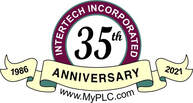Allen-Bradley PLC-5
Maintenance & Troubleshooting
Module: 201
Maintaining, troubleshooting, and programming a programmable control system requires a thorough understanding of the system hardware and software. This course provides a fundamental understanding of the installation, configuration, layout, troubleshooting procedures, and maintenance procedures for the Allen-Bradley PLC-5 programmable controller and input/output systems. In addition, programming concepts for contact, coil, timer, and counter instructions are introduced. This course is conducted using Rockwell RSLogix-5, 6200, or Advanced Interface (AI) software, depending on student preference.
Objectives
Objectives
- Understand the major functional components of the Allen-Bradley PLC-5 programmable control system as it relates to your facility's installation.
- Discuss design considerations for system architecture, processor selection, input/output module type selection, power supply selection, and communication system layout.
- Study the two families of PLC-5 controller: Classic and Enhanced.
- Cover rules for chassis, processor, adapter, power supply, and input/output module placement.
- Consider issues relevant when replacing existing controller, power supplies, chassis, and modules.
- Determine the meaning of LED indicator lights, and dip switch positions on processors, modules, power supplies, and chassis.
- Discuss battery purpose, replacement procedures, and environmental concerns for disposal.
- Know the differences in capabilities of local, extended local, remote, and ControlNet I/O systems.
- Discuss field devices and signal types and levels pertaining to I/O module selection.
- Understand the relationship between field devices, I/O modules, and I/O addressing.
- Examine the differences and learn the concepts of 2, 1, and ½ slot addressing.
- Become familiar with the memory layout and configuration of the PLC-5 processor, data table, program files, free memory, edit buffer, etc.
- Understand and use the different communication interfaces available on the PLC-5 processors, DF1 serial, DH+, and Ethernet.
- Configure programming software or RSLinx to communicate with a PLC-5 processor.
- Know difference between online and offline programming.
- Document and organize your programs to and from the personal computer and the PLC-5.
- Design, build, test, and troubleshoot ladder logic control circuits involving contact, coil, timer, and counter instructions.
- Discuss the need for and use of the Block Transfer, BTR, and BTW instructions.
- Use the programming software as a diagnostic and troubleshooting tool.
- Isolate hardware and software problems from field device problems.
- Use system diagnostics to identify and pinpoint faults in the system.
- Develop a thorough understanding of and the safety issues related to Forcing in the PLC-5.
- Is the circuit really off? Discuss appropriate safety issues.
Technical Education Is The Key That Unlocks The Door To Improved Communications Throughout Your Organization
|
© 1986 - 2019 Intertech Incorporated. All rights reserved.
|
| ||


